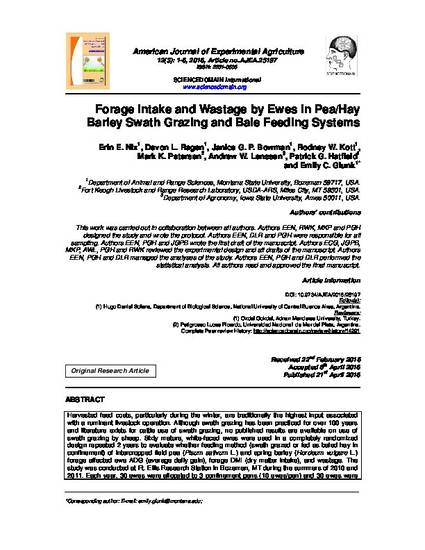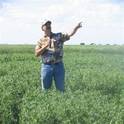
Harvested feed costs, particularly during the winter, are traditionally the highest input associated with a ruminant livestock operation. Although swath grazing has been practiced for over 100 years and literature exists for cattle use of swath grazing, no published results are available on use of swath grazing by sheep. Sixty mature, white-faced ewes were used in a completely randomized design repeated 2 years to evaluate whether feeding method (swath grazed or fed as baled hay in confinement) of intercropped field pea (Pisum sativum L.) and spring barley (Hordeum vulgare L.) forage affected ewe ADG (average daily gain), forage DMI (dry matter intake), and wastage. The study was conducted at Ft. Ellis Research Station in Bozeman, MT during the summers of 2010 and 2011. Each year, 30 ewes were allocated to 3 confinement pens (10 ewes/pen) and 30 ewes were allocated to 3 grazing plots (10 ewes/plot). Ewes had ad libitum access to forage and water. Individual ewe forage DMI was estimated using chromic oxide (Cr2O3) as a marker for estimating fecal output. Measures of fecal output were combined with measures of forage indigestibility to determine DMI for each ewe. Forage wastage was calculated by sampling and weighing initial available forage, and subtracting final available forage and DMI. Forage DMI (P ≥ 0.13), ewe ADG (P≥ 0.40), and forage percent wastage (P > 0.28) did not differ for swathed versus baled pea/hay barley forage during either year. These results suggest that a swathed feeding system can function as a viable alternative to a traditional baled feeding system for pea/hay barley forage in commercial sheep operations.
Available at: http://works.bepress.com/andrew_lenssen/97/

This article is from American Journal of Experimental Agriculture 12 (2016): 1–6, doi:10.9734/AJEA/2016/25197.